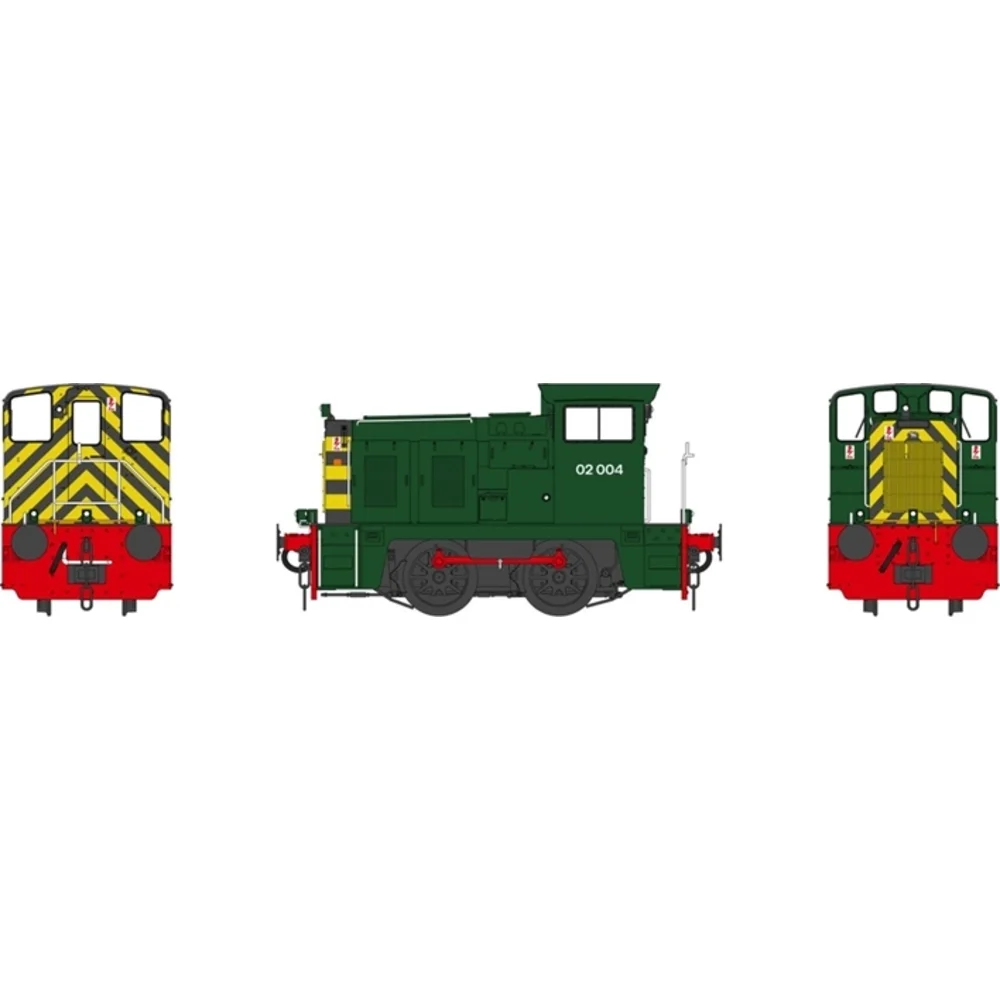Heljan 2844
British Rail Class 02 02004 British Railways Green
Tooling
Heljan’s OO gauge model of the British Rail Class 02 0-4-0 diesel-hydraulic shunter was announced as part of their 2024 range and delivered to retailers in early 2025. The prototype locomotives were built by the Yorkshire Engine Company between 1960 and 1961 for dockside and yard duties in areas with tight curves, primarily in the Liverpool and Manchester regions. With only 20 built, these diminutive shunters became a distinctive part of BR’s London Midland Region and later found extended service in industry and preservation. Heljan’s tooling fills a long-standing gap for ready-to-run models of this class in OO gauge.
Tooling Features
- Scale & Construction: OO gauge (1:76), injection-moulded plastic body with a die-cast metal chassis for weight and stability.
- Detailing: Separately fitted fine wire handrails, etched radiator grilles, lamp irons, wipers, pipework, and detailed cab interior with painted controls and glazing.
- Couplings: NEM pockets with tension-lock couplers supplied; optional three-link coupling hooks and chains included for bufferbeam detailing.
- Finish: Precision-applied liveries with authentic lining, printed data panels, and weathered options on selected models.
Mechanical & Electrical
- Drive System: High-quality 5-pole motor with flywheel for smooth, quiet running and excellent low-speed control.
- Weighting: Die-cast chassis provides good traction for shunting duties.
- Minimum Radius: Compatible with 1st radius curves, ideal for compact layouts.
- Lighting: Directional LED marker lights and cab interior lighting; cab lights operable in DC mode via magnetic wand supplied.
DCC Capability
- Interface: DCC-ready with Next18 decoder socket.
- Sound: Provision for DCC sound installation; factory-fitted speaker included in most versions.
Liveries Produced
Initial releases cover a wide range of authentic and industrial schemes, including:
- BR Green (early and late variations, with red or yellow bufferbeams)
- BR Blue with wasp stripes
- Industrial Yellow with wasp stripes
- Industrial Green (‘SAM’, weathered)
- Redland Khaki (‘Diane’, Gaugemaster Collection)
Reviews & Commentary
Early reviews and social media feedback have praised the model for its superb detailing, smooth and quiet mechanism, and suitability for micro-layouts and shunting scenes. The inclusion of cab lighting and magnetic wand control in DC mode has been highlighted as a thoughtful feature. Some reviewers noted minor issues such as bent handrails on a few samples, but overall reception has been positive, with many considering it a “miniature marvel” for OO gauge enthusiasts.
Interesting Notes
- The prototype Class 02 locomotives were fitted with Rolls-Royce C6NFL engines and were designed to replace the L&Y ‘Pug’ steam shunters.
- Seven examples of the class survive in preservation, including D2860 at the National Railway Museum.
Heljan’s Class 02 tooling combines historical accuracy with modern digital compatibility, making it an attractive choice for modellers seeking a highly detailed, compact shunter for industrial or dockside layouts.
Class & Prototype
- Class: British Rail Class 02
- Traction: Diesel
- Transmission: Hydraulic
- Built: 1960-1961
- Total Built: 20
No prototype found.
Operator & Livery
- Operator: British Railways
- Livery: Green
British Railways transformed Britain's fragmented rail network into a unified national system following nationalisation on 1st January 1948. Created from the "Big Four" companies under the Transport Act 1947, BR operated most of Great Britain's railways until rebranding as British Rail in 1965, managing over 20,000 route miles and inheriting nearly 20,000 locomotives of diverse designs.
The organisation pioneered standardisation through its revolutionary BR Standard locomotive programme (1951-1960), producing 999 advanced steam engines under Robert Riddles' direction. These included the versatile Britannia Pacifics, mighty 9F freight engines, and mixed-traffic classes that incorporated the best features from all predecessor companies. The 1955 Modernisation Plan accelerated diesel and electric traction development, creating fascinating mixed-traction operations.
Notable achievements included establishing unified locomotive classification systems, introducing distinctive corporate liveries, and managing the complex transition from steam to modern traction. BR's six regional structure preserved operational diversity whilst enabling standardisation of practices, signalling, and rolling stock that had eluded private enterprise for over a century.
The BR era represents steam traction's final flowering alongside emerging diesel technology, creating unparalleled locomotive variety. Today, this heritage remains highly popular with railway enthusiasts through extensive preserved fleets, heritage railway operations, and comprehensive model ranges from manufacturers like Hornby, Bachmann, and Dapol, making BR subjects essential for authentic post-war British railway modelling across all scales.

